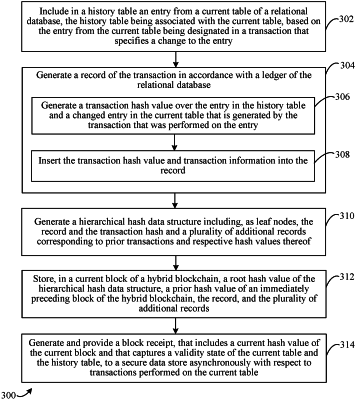| CPC H04L 9/3239 (2013.01) [G06F 16/2282 (2019.01); G06F 16/2379 (2019.01); G06F 16/284 (2019.01); H04L 9/50 (2022.05)] | 20 Claims |

|
1. A method performed by a computing system, the method comprising:
including in a history table an entry from a current table of a relational database, the history table being associated with the current table, based on the entry from the current table being designated in a transaction that specifies a change to the entry;
generating a record of the transaction in accordance with a ledger of the relational database by:
generating a transaction hash value by hashing the entry in the history table and a changed entry in the current table that is generated by the transaction that was performed on the entry; and
inserting the transaction hash value and transaction information into the record;
generating a hierarchical hash data structure including, as leaf nodes:
the record and the transaction hash, and
a plurality of additional records corresponding to prior transactions and respective hash values thereof;
storing, in a current block of a hybrid blockchain, a root hash value of the hierarchical hash data structure, a prior hash value of an immediately preceding block of the hybrid blockchain, the record, and the plurality of additional records;
generating, asynchronously with respect to transactions performed on the current table, a block receipt that includes a current hash value of the current block and that captures a validity state of the current table, the history table, and the ledger; and
providing the block receipt to a secure data store.
|